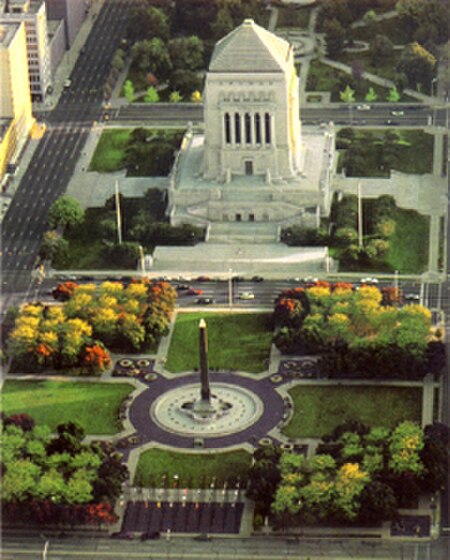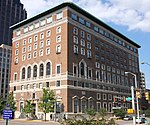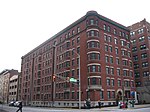Indiana World War Memorial Plaza

The Indiana World War Memorial Plaza is an urban feature and war memorial located in downtown Indianapolis, Indiana, United States, originally built to honor the veterans of World War I. It was conceived in 1919 as a location for the national headquarters of the American Legion and a memorial to the state's and nation's veterans. The original five-block plaza is bounded by Meridian Street (west), St. Clair Street (north), Pennsylvania Street (east), and New York Street (south). American Legion Mall comprises the two northernmost blocks and is home to the Legion's administrative buildings and a cenotaph. Veterans Memorial Plaza, with its obelisk, forms the third block. The plaza's focal point, the Indiana World War Memorial, is located on the fourth block. Modeled after the Mausoleum of Halicarnassus, it houses a military museum and auditorium. The fifth and southernmost block is University Park, home to statues and a fountain.On October 11, 1994, the Indiana World War Memorial Plaza was designated a National Historic Landmark District. In 2016, the district was enlarged to include in its scope the Soldiers' and Sailors' Monument and was renamed the Indiana World War Memorial Historic District. Combined, it is the largest war memorial project in the United States, encompassing 24 acres (9.7 ha).
Excerpt from the Wikipedia article Indiana World War Memorial Plaza (License: CC BY-SA 3.0, Authors, Images).Indiana World War Memorial Plaza
North Meridian Street, Indianapolis
Geographical coordinates (GPS) Address Website External links Nearby Places Show on map
Geographical coordinates (GPS)
| Latitude | Longitude |
|---|---|
| N 39.773611111111 ° | E -86.156944444444 ° |
Address
Indiana World War Memorial
North Meridian Street 431
46204 Indianapolis
Indiana, United States
Open on Google Maps










